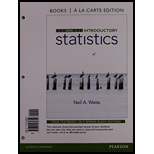
Concept explainers
Note: The data for the Using Technology exercises are on the WeirsStats website.
B.47 Slopping Distance. Refer to Exercise B 44. where the problem is to determine a polynomial regression model for the relationship between stopping distance and car speed. Use the technology of your choice to obtain computer output similar to Outputs B.33-B.35 on pages B-54-B-56.
- a. Based on the scallcrplol of stopping distance versus speed, what degree polynomial would you use to fit the data?
- b. Based on the regression analyses for polynomials of degrees one through live, apply the forward selection method to select a polynomial regression equation for these data. Use a 5% level of significance.
- c. Based on the regression analyses for polynomials of degrees one through five, apply the backward elimination method to select a polynomial regression equation for these data. Use α = 0.05.
- d. Do the forward selection and backward elimination methods yield the same result?
- e. Interpret the plots of residuals versus fitted values for the linear, quadratic, and cubic polynomial fits with regard to the appropriateness of each of the three polynomial regression equations. Do these interpretations agree with the regression models obtained in parts (b) and (cl? Which regression model would you select?
- f. Using the plot of residuals versus fitted values for the polynomial regression equation that you selected in part (e), assess the assumption of equal conditional standard deviations.
- g. For the polynomial regression equation that you selected in part (e\ obtain a normal probability plot of the residuals, and assess the assumption of normality of the conditional distributions.
- h. It appears that a polynomial regression model may not be completely appropriate here. Based on your results from the previous parts of this exercise, decide on a suitable transformation and perform regression and residual analyses for that model. Discuss your findings and compare, with regard to the assumptions for regression inferences, the model obtained using the method of transformations to the one selected in part (e).
Want to see the full answer?
Check out a sample textbook solution
Chapter B Solutions
Introductory Statistics, Books a la Carte Plus NEW MyLab Statistics with Pearson eText -- Access Card Package (10th Edition)
Additional Math Textbook Solutions
Calculus: Early Transcendentals (2nd Edition)
College Algebra (7th Edition)
Mathematics for the Trades: A Guided Approach (11th Edition) (What's New in Trade Math)
A First Course in Probability (10th Edition)
Precalculus: A Unit Circle Approach (3rd Edition)
Graphical Approach To College Algebra
- A marketing agency wants to determine whether different advertising platforms generate significantly different levels of customer engagement. The agency measures the average number of daily clicks on ads for three platforms: Social Media, Search Engines, and Email Campaigns. The agency collects data on daily clicks for each platform over a 10-day period and wants to test whether there is a statistically significant difference in the mean number of daily clicks among these platforms. Conduct ANOVA test. You can provide your answer by inserting a text box and the answer must include: also please provide a step by on getting the answers in excel Null hypothesis, Alternative hypothesis, Show answer (output table/summary table), and Conclusion based on the P value.arrow_forwardA company found that the daily sales revenue of its flagship product follows a normal distribution with a mean of $4500 and a standard deviation of $450. The company defines a "high-sales day" that is, any day with sales exceeding $4800. please provide a step by step on how to get the answers Q: What percentage of days can the company expect to have "high-sales days" or sales greater than $4800? Q: What is the sales revenue threshold for the bottom 10% of days? (please note that 10% refers to the probability/area under bell curve towards the lower tail of bell curve) Provide answers in the yellow cellsarrow_forwardBusiness Discussarrow_forward
- The following data represent total ventilation measured in liters of air per minute per square meter of body area for two independent (and randomly chosen) samples. Analyze these data using the appropriate non-parametric hypothesis testarrow_forwardeach column represents before & after measurements on the same individual. Analyze with the appropriate non-parametric hypothesis test for a paired design.arrow_forwardShould you be confident in applying your regression equation to estimate the heart rate of a python at 35°C? Why or why not?arrow_forward
 Algebra & Trigonometry with Analytic GeometryAlgebraISBN:9781133382119Author:SwokowskiPublisher:Cengage
Algebra & Trigonometry with Analytic GeometryAlgebraISBN:9781133382119Author:SwokowskiPublisher:Cengage
 Glencoe Algebra 1, Student Edition, 9780079039897...AlgebraISBN:9780079039897Author:CarterPublisher:McGraw Hill
Glencoe Algebra 1, Student Edition, 9780079039897...AlgebraISBN:9780079039897Author:CarterPublisher:McGraw Hill Functions and Change: A Modeling Approach to Coll...AlgebraISBN:9781337111348Author:Bruce Crauder, Benny Evans, Alan NoellPublisher:Cengage Learning
Functions and Change: A Modeling Approach to Coll...AlgebraISBN:9781337111348Author:Bruce Crauder, Benny Evans, Alan NoellPublisher:Cengage Learning College Algebra (MindTap Course List)AlgebraISBN:9781305652231Author:R. David Gustafson, Jeff HughesPublisher:Cengage Learning
College Algebra (MindTap Course List)AlgebraISBN:9781305652231Author:R. David Gustafson, Jeff HughesPublisher:Cengage Learning





